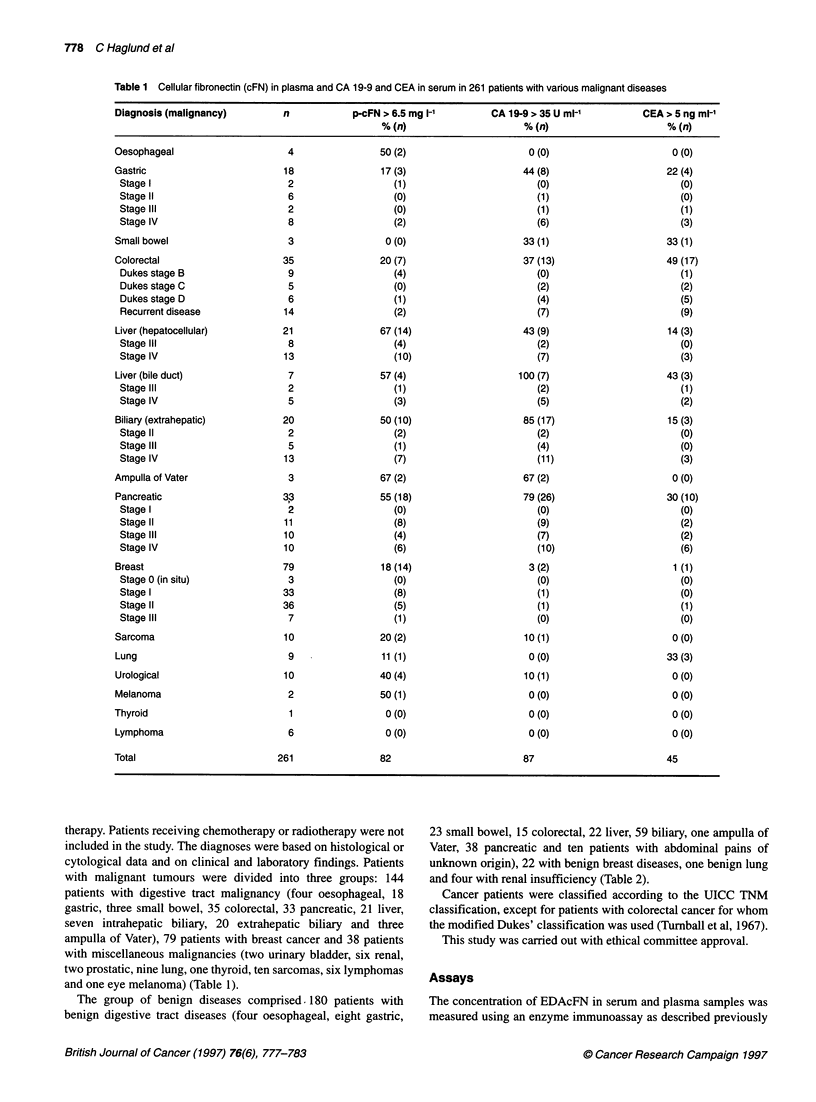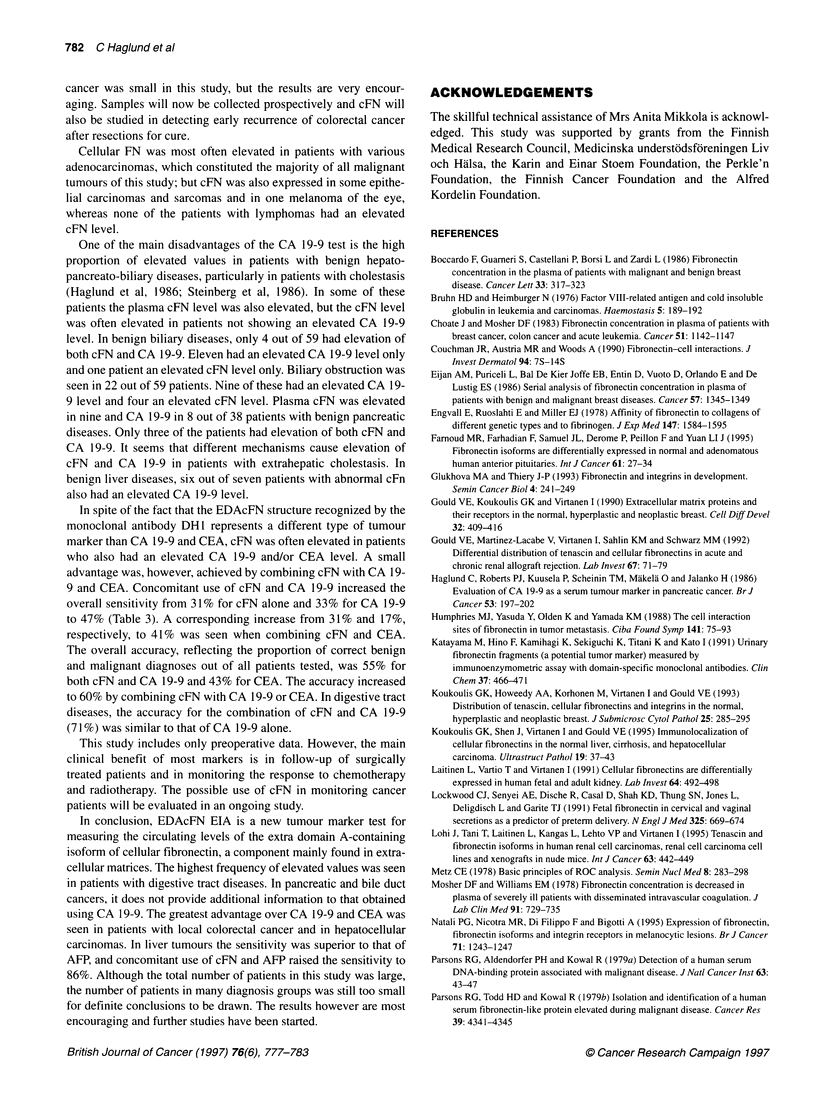Abstract
EDAcFN enzyme immunoassay (EIA) is a new tumour marker assay measuring the extra domain A-containing isoform of cellular fibronectin (cFN), a component mainly found in extracellular matrices. The concentration cFN was measured in plasma and serum from 468 patients with malignant and benign diseases. The concentrations of cFN were higher in plasma than in serum. Using receiver operating characteristic (ROC) curve analysis, determination from plasma was superior to serum at specificity levels higher than 78% and was chosen for further analysis. The highest frequencies of elevated cFN values were seen in patients with hepato-pancreato-biliary malignancies (50-67%). In pancreatic and bile duct cancers, cFN provided little further information to that obtained by CA 19-9. The greatest advantage over CA 19-9 and CEA was seen in patients with local colorectal cancer and in hepatocellular carcinomas. Four out of nine patients with Dukes' stage B colorectal cancer had an elevated cFn level, but only one had an abnormal CEA level. In hepatocellular carcinomas, cFN was also compared with alpha-fetoprotein. The sensitivity of cFN (72%) was superior to that of AFP (61%), and concomitant use of cFN and AFP raised the sensitivity to 83%. The highest frequencies of elevated values in patients with benign diseases were observed in those with severe liver disease (32%) and biliary (17%) and pancreatic (24%) diseases. A combination of cFN and CA 19-9 showed the highest overall sensitivity of 47%, compared with 31% for cFN and 33% for CA 19-9. The corresponding specificities were 76% for cFN +/- CA 19-9, 85% for cFN and 83% for CA 19-9. The accuracy of a combination of cFN and CA 19-9 or CEA (60% respectively) was higher than that of cFN (55%), CA 19-9 (55%) or CEA (45%) alone. In conclusion, the results of the new cFN test are encouraging and further studies on larger patient materials have been started.
Full text
PDF






Selected References
These references are in PubMed. This may not be the complete list of references from this article.
- Boccardo F., Guarneri D., Zanardi S., Castellani P., Borsi L., Zardi L. Fibronectin concentration in the plasma of patients with malignant and benign breast disease. Cancer Lett. 1986 Dec;33(3):317–323. doi: 10.1016/0304-3835(86)90071-6. [DOI] [PubMed] [Google Scholar]
- Bruhn H. D., Heimburger N. Factor-VIII-related antigen and cold-insoluble globulin in leukemias and carcinomas. Haemostasis. 1976;5(3):189–192. doi: 10.1159/000214134. [DOI] [PubMed] [Google Scholar]
- Choate J. J., Mosher D. F. Fibronectin concentration in plasma of patients with breast cancer, colon cancer, and acute leukemia. Cancer. 1983 Mar 15;51(6):1142–1147. doi: 10.1002/1097-0142(19830315)51:6<1142::aid-cncr2820510628>3.0.co;2-s. [DOI] [PubMed] [Google Scholar]
- Couchman J. R., Austria M. R., Woods A. Fibronectin-cell interactions. J Invest Dermatol. 1990 Jun;94(6 Suppl):7S–14S. doi: 10.1111/1523-1747.ep12874973. [DOI] [PubMed] [Google Scholar]
- Eiján A. M., Puricelli L., Bal de Kier Joffé E., Entin D., Vuoto D., Orlando E., Sacerdote de Lustig E. Serial analysis of fibronectin concentration in plasma of patients with benign and malignant breast diseases. Cancer. 1986 Apr 1;57(7):1345–1349. doi: 10.1002/1097-0142(19860401)57:7<1345::aid-cncr2820570717>3.0.co;2-r. [DOI] [PubMed] [Google Scholar]
- Engvall E., Ruoslahti E., Miller E. J. Affinity of fibronectin to collagens of different genetic types and to fibrinogen. J Exp Med. 1978 Jun 1;147(6):1584–1595. doi: 10.1084/jem.147.6.1584. [DOI] [PMC free article] [PubMed] [Google Scholar]
- Farnoud M. R., Farhadian F., Samuel J. L., Derome P., Peillon F., Li J. Y. Fibronectin isoforms are differentially expressed in normal and adenomatous human anterior pituitaries. Int J Cancer. 1995 Mar 29;61(1):27–34. doi: 10.1002/ijc.2910610106. [DOI] [PubMed] [Google Scholar]
- Glukhova M. A., Thiery J. P. Fibronectin and integrins in development. Semin Cancer Biol. 1993 Aug;4(4):241–249. [PubMed] [Google Scholar]
- Gould V. E., Koukoulis G. K., Virtanen I. Extracellular matrix proteins and their receptors in the normal, hyperplastic and neoplastic breast. Cell Differ Dev. 1990 Dec 2;32(3):409–416. doi: 10.1016/0922-3371(90)90057-4. [DOI] [PubMed] [Google Scholar]
- Gould V. E., Martinez-Lacabe V., Virtanen I., Sahlin K. M., Schwartz M. M. Differential distribution of tenascin and cellular fibronectins in acute and chronic renal allograft rejection. Lab Invest. 1992 Jul;67(1):71–79. [PubMed] [Google Scholar]
- Haglund C., Roberts P. J., Kuusela P., Scheinin T. M., Mäkelä O., Jalanko H. Evaluation of CA 19-9 as a serum tumour marker in pancreatic cancer. Br J Cancer. 1986 Feb;53(2):197–202. doi: 10.1038/bjc.1986.35. [DOI] [PMC free article] [PubMed] [Google Scholar]
- Humphries M. J., Yasuda Y., Olden K., Yamada K. M. The cell interaction sites of fibronectin in tumour metastasis. Ciba Found Symp. 1988;141:75–93. doi: 10.1002/9780470513736.ch5. [DOI] [PubMed] [Google Scholar]
- Katayama M., Hino F., Kamihagi K., Sekiguchi K., Titani K., Kato I. Urinary fibronectin fragments (a potential tumor marker) measured by immunoenzymometric assay with domain-specific monoclonal antibodies. Clin Chem. 1991 Mar;37(3):466–471. [PubMed] [Google Scholar]
- Koukoulis G. K., Howeedy A. A., Korhonen M., Virtanen I., Gould V. E. Distribution of tenascin, cellular fibronectins and integrins in the normal, hyperplastic and neoplastic breast. J Submicrosc Cytol Pathol. 1993 Apr;25(2):285–295. [PubMed] [Google Scholar]
- Koukoulis G. K., Shen J., Virtanen I., Gould V. E. Immunolocalization of cellular fibronectins in the normal liver, cirrhosis, and hepatocellular carcinoma. Ultrastruct Pathol. 1995 Jan-Feb;19(1):37–43. doi: 10.3109/01913129509014601. [DOI] [PubMed] [Google Scholar]
- Laitinen L., Vartio T., Virtanen I. Cellular fibronectins are differentially expressed in human fetal and adult kidney. Lab Invest. 1991 Apr;64(4):492–498. [PubMed] [Google Scholar]
- Lockwood C. J., Senyei A. E., Dische M. R., Casal D., Shah K. D., Thung S. N., Jones L., Deligdisch L., Garite T. J. Fetal fibronectin in cervical and vaginal secretions as a predictor of preterm delivery. N Engl J Med. 1991 Sep 5;325(10):669–674. doi: 10.1056/NEJM199109053251001. [DOI] [PubMed] [Google Scholar]
- Lohi J., Tani T., Laitinen L., Kangas L., Lehto V. P., Virtanen I. Tenascin and fibronectin isoforms in human renal cell carcinomas, renal cell carcinoma cell lines and xenografts in nude mice. Int J Cancer. 1995 Nov 3;63(3):442–449. doi: 10.1002/ijc.2910630324. [DOI] [PubMed] [Google Scholar]
- Metz C. E. Basic principles of ROC analysis. Semin Nucl Med. 1978 Oct;8(4):283–298. doi: 10.1016/s0001-2998(78)80014-2. [DOI] [PubMed] [Google Scholar]
- Mosher D. F., Williams E. M. Fibronectin concentration is decreased in plasma of severely ill patients with disseminated intravascular coagulation. J Lab Clin Med. 1978 May;91(5):729–735. [PubMed] [Google Scholar]
- Natali P. G., Nicotra M. R., Di Filippo F., Bigotti A. Expression of fibronectin, fibronectin isoforms and integrin receptors in melanocytic lesions. Br J Cancer. 1995 Jun;71(6):1243–1247. doi: 10.1038/bjc.1995.240. [DOI] [PMC free article] [PubMed] [Google Scholar]
- Parsons R. G., Aldenderfer P. H., Kowal R. Detection of a human serum DNA-binding protein associated with malignant disease. J Natl Cancer Inst. 1979 Jul;63(1):43–47. [PubMed] [Google Scholar]
- Parsons R. G., Todd H. D., Kowal R. Isolation and identification of a human serum fibronectin-like protein elevated during malignant disease. Cancer Res. 1979 Nov;39(11):4341–4345. [PubMed] [Google Scholar]
- Peters J. H., Ginsberg M. H., Case C. M., Cochrane C. G. Release of soluble fibronectin containing an extra type III domain (ED1) during acute pulmonary injury mediated by oxidants or leukocytes in vivo. Am Rev Respir Dis. 1988 Jul;138(1):167–174. doi: 10.1164/ajrccm/138.1.167. [DOI] [PubMed] [Google Scholar]
- Peters J. H., Maunder R. J., Woolf A. D., Cochrane C. G., Ginsberg M. H. Elevated plasma levels of ED1+ ("cellular") fibronectin in patients with vascular injury. J Lab Clin Med. 1989 May;113(5):586–597. [PubMed] [Google Scholar]
- Ruelland A., Kerbrat P., Clerc C., Legras B., Cloarec L. Level of plasma fibronectin in patients with breast cancer. Clin Chim Acta. 1988 Dec 30;178(3):283–287. doi: 10.1016/0009-8981(88)90236-7. [DOI] [PubMed] [Google Scholar]
- Siri A., Carnemolla B., Raffanti S., Castellani P., Balzano E., Zardi L. Fibronectin concentrations in pleural effusions of patients with malignant and non-malignant diseases. Cancer Lett. 1984 Feb;22(1):1–9. doi: 10.1016/0304-3835(84)90037-5. [DOI] [PubMed] [Google Scholar]
- Stathakis N. E., Fountas A., Tsianos E. Plasma fibronectin in normal subjects and in various disease states. J Clin Pathol. 1981 May;34(5):504–508. doi: 10.1136/jcp.34.5.504. [DOI] [PMC free article] [PubMed] [Google Scholar]
- Stathakis N. E., Mosesson M. W. Interactions among heparin, cold-insoluble globulin, and fibrinogen in formation of the heparin-precipitable fraction of plasma. J Clin Invest. 1977 Oct;60(4):855–865. doi: 10.1172/JCI108840. [DOI] [PMC free article] [PubMed] [Google Scholar]
- Steinberg W. M., Gelfand R., Anderson K. K., Glenn J., Kurtzman S. H., Sindelar W. F., Toskes P. P. Comparison of the sensitivity and specificity of the CA19-9 and carcinoembryonic antigen assays in detecting cancer of the pancreas. Gastroenterology. 1986 Feb;90(2):343–349. doi: 10.1016/0016-5085(86)90930-3. [DOI] [PubMed] [Google Scholar]
- Tamkun J. W., Hynes R. O. Plasma fibronectin is synthesized and secreted by hepatocytes. J Biol Chem. 1983 Apr 10;258(7):4641–4647. [PubMed] [Google Scholar]
- Todd H. D., Coffee M. S., Waalkes T. P., Abeloff M. D., Parsons R. G. Serum levels of fibronectin and a fibronectin-like DNA-binding protein in patients with various diseases. J Natl Cancer Inst. 1980 Nov;65(5):901–904. [PubMed] [Google Scholar]
- Turnbull R. B., Jr, Kyle K., Watson F. R., Spratt J. Cancer of the colon: the influence of the no-touch isolation technic on survival rates. Ann Surg. 1967 Sep;166(3):420–427. doi: 10.1097/00000658-196709000-00010. [DOI] [PMC free article] [PubMed] [Google Scholar]
- Vartio T., Laitinen L., Närvänen O., Cutolo M., Thornell L. E., Zardi L., Virtanen I. Differential expression of the ED sequence-containing form of cellular fibronectin in embryonic and adult human tissues. J Cell Sci. 1987 Nov;88(Pt 4):419–430. doi: 10.1242/jcs.88.4.419. [DOI] [PubMed] [Google Scholar]
- Virtanen I., Laitinen L., Vartio T. Differential expression of the extra domain-containing form of cellular fibronectin in human placentas at different stages of maturation. Histochemistry. 1988;90(1):25–30. doi: 10.1007/BF00495702. [DOI] [PubMed] [Google Scholar]
- Webb K. S., Lin G. H. Urinary fibronectin: potential as a biomarker in prostatic cancer. Invest Urol. 1980 Mar;17(5):401–404. [PubMed] [Google Scholar]
- Ylätupa S., Haglund C., Mertaniemi P., Vahtera E., Partanen P. Cellular fibronectin in serum and plasma: a potential new tumour marker? Br J Cancer. 1995 Mar;71(3):578–582. doi: 10.1038/bjc.1995.112. [DOI] [PMC free article] [PubMed] [Google Scholar]
- Ylätupa S., Partanen P., Haglund C., Virtanen I. Competitive enzyme immunoassay for quantification of the cellular form of fibronectin (EDAcFN) in blood samples. J Immunol Methods. 1993 Jul 6;163(1):41–47. doi: 10.1016/0022-1759(93)90237-2. [DOI] [PubMed] [Google Scholar]


